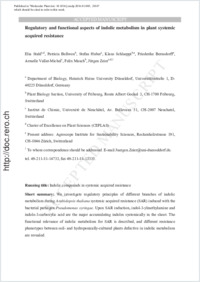Regulatory and functional aspects of indolic metabolism in plant systemic acquired resistance
- Stahl, Elia Department of Biology, Heinrich Heine University Düsseldorf, Germany - Cluster of Excellence on Plant Sciences (CEPLAS)
- Bellwon, Patricia Plant Biology Section, University of Fribourg, Switzerland
- Huber, Stefan Department of Biology, Heinrich Heine University Düsseldorf, Germany
- Schlaeppi, Klaus Plant Biology Section, University of Fribourg, Switzerland -
- Bernsdorff, Friederike Department of Biology, Heinrich Heine University Düsseldorf, Germany
- Vallat-Michel, Armelle Institut de Chimie, Université de Neuchâtel, Switzerland
- Mauch, Felix Plant Biology Section, University of Fribourg, Switzerland
- Zeier, Jürgen Department of Biology, Heinrich Heine University Düsseldorf, Germany - Cluster of Excellence on Plant Sciences (CEPLAS)
-
20.01.2016
Published in:
- Molecular Plant. - 2016, vol. 9, no. 5, p. 662-681
English
Tryptophan-derived, indolic metabolites possess diverse functions in Arabidopsis innate immunity to microbial pathogen infection. Here, we investigate the functional role and regulatory characteristics of indolic metabolism in Arabidopsis systemic acquired resistance (SAR) triggered by the bacterial pathogen Pseudomonas syringae. Indolic metabolism is broadly activated in both P. syringae-inoculated and in distant, non-inoculated leaves. At inoculation sites, camalexin, indol-3-ylmethylamine (I3A), and indole-3-carboxylic acid (ICA) are the major accumulating compounds, along with about 20 other detected indolics. Camalexin accumulation is positively affected by the transcription factor MYB122, and by the cytochrome P450 genes CYP81F1 and CYP81F2. Local I3A production, by contrast, occurs via indole glucosinolate breakdown by pathways dependent and independent of the myrosinase PEN2. Moreover, exogenous application of the defense hormone salicylic acid stimulates I3A generation at the expense of its precursor indol-3-ylmethylglucosinolate (I3M), and the SAR regulator pipecolic acid primes plants for enhanced P. syringae-induced activation of distinct branches of indolic metabolism. In uninfected systemic tissue, the metabolic response is more specific and associated with enhanced levels of the indolics I3A, ICA, and indole-3-carbaldehyde (ICC). Systemic indole accumulation fully depends on functional CYP79B2/3, PEN2, and MYB34/51/122, and requires functional SAR signalling. Mutant analyses suggest that systemically elevated indoles are dispensable for SAR directed against P. syringae and associated systemic increases of salicylic acid. However, soil-grown but not hydroponically-cultivated cyp79b2/3 and pen2 plants, both defective in indolic secondary metabolism, exhibit pre-induced immunity, which abrogates their intrinsic ability to induce SAR.
- Faculty
- Faculté des sciences et de médecine
- Department
- Département de Biologie
- Language
-
- English
- Classification
- Biological sciences
- License
- License undefined
- Identifiers
-
- RERO DOC 258308
- DOI 10.1016/j.molp.2016.01.005
- Persistent URL
- https://folia.unifr.ch/unifr/documents/304629
Statistics
Document views: 68
File downloads:
- mau_rfa.pdf: 174
